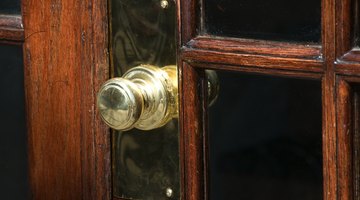How to Restore Brass Door Knobs
Cleaning, polishing and restoring brass door knobs can add sparkle and a touch of class to a home. How you approach the project depends what kind of brass you have, how badly tarnished or degraded it is, and whether it is solid or plated.

Brass is an alloy of copper and zinc, with tin or aluminum added to some types for corrosion and tarnish resistance. Cleaning and polishing brass door knobs and hardware is an excellent do-it-yourself project, but re-plating is best left to professional restorers.
Things You Will Need
- Latex gloves
- Denatured alcohol
- Paint stripper
- Nail polish remover
- Lacquer thinner
- Vinegar
- Salt
- 0000 steel wool
- Old t-shirts or other soft cloths
- Caustic or acidic commercial brass cleaners and polishes
- Door hardware restoration and re-plating vendor
Warning
Always have adequate ventilation when using chemicals for cleaning and polishing brass.
Either caustic or acidic chemicals can burn so wear protective gloves.
-
Use a reasonably strong magnet to determine whether your doorknobs are solid or plated brass. A magnet is attracted to metal, like steel or zinc, underneath plating but will not stick to brass alloys.
-
Remove lacquer if the brass has been sprayed with a protective finish. Denatured alcohol, paint stripper or even nail polish remover are possible choices. Use as sparingly as possible.
-
Scour the doorknob to remove the surface layer of built-up grime, corrosion and tarnish. Use a lacquer thinner or a mixture of vinegar and salt, scour with 0000 steel wool (the finest available) on solid brass but very carefully on plated surfaces. An old soft t-shirt is a better choice for thin, brass-plated surfaces.
-
Soak heavily tarnished brass with ammonia. Ammonia is caustic and can pit or degrade brass if you leave it on too long so watch the chemical reaction carefully. Neutralize with a spray of diluted vinegar to stop the process.
-
Apply a thin layer of commercial brass cleaner or polish and allow to dry. Cleaners or polishes come in both caustic and acidic formulas and you may have to experiment with what works best for your situation. Generally, acidic formulas react just with the tarnished brass whereas caustic ones react with the brass itself.
-
Buff with a soft cloth to remove all polish and repeat process until the brass shines and all of the tarnish is removed.
-
Send badly tarnished, degraded or eroded brass plate to a commercial door hardware restorer and re-plater. These companies have abrasive blasters, polishing wheels and compounds, and re-plating equipment.
The Drip Cap
- Cleaning, polishing and restoring brass door knobs can add sparkle and a touch of class to a home.
- Use as sparingly as possible.
- Ammonia is caustic and can pit or degrade brass if you leave it on too long so watch the chemical reaction carefully.
- Apply a thin layer of commercial brass cleaner or polish and allow to dry.
- Buff with a soft cloth to remove all polish and repeat process until the brass shines and all of the tarnish is removed.
References
Resources
Writer Bio
Steven Sester has written and published for others as a public relations professional since the 1970s. His areas of expertise include the fine and performing arts, home improvement, emerging technology, alternative healthcare, environmental and sustainability issues, entrepreneurship and a variety of other topics. He is a graduate of the New College program at San Jose State University.
Photo Credits
- Jupiterimages/Photos.com/Getty Images
- Jupiterimages/Photos.com/Getty Images
More Articles



